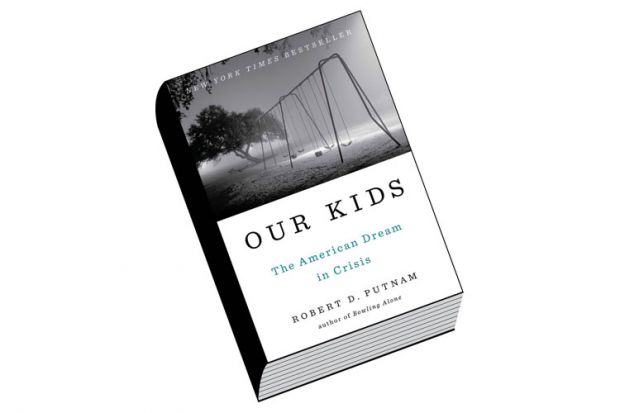Newsflash! The American dream is in crisis! The US has a problem with childhood poverty! According to the National Center for Children in Poverty, 22 per cent of American children live below the poverty line and 45 per cent live in (very) low-income families. It’s not news, but it’s also not on the political agenda.
Who better, then, to launch a child poverty campaign than Robert Putnam, the poster boy for “academic impact”? In the wake of his 2000 book Bowling Alone: The Collapse and Revival of American Community, he helped a little-known senator from Illinois, Barack Obama, establish the importance of community organisations, and this would prove to be a winning political strategy.
Presumably, when President Obama worried in 2009 that the economic crisis was “like the American Dream in reverse”, Putnam began writing this book. Long before its publication, he carried its message to Washington’s leaders on both sides of the political divide – not just Obama, but Republican Rand Paul, too. Our Kids challenges candidates to resuscitate an American dream, or at least to debate the opportunities gap between rich and poor. The intention here is a well-timed political intervention.
Unfortunately, the outcome is a contrived and highly derivative ode to Putnam’s childhood: from the opening line (“My hometown was, in the 1950s, a passable embodiment of the American Dream”) to his heartfelt introductions of fellow 1959 high school graduates of Port Clinton, Ohio, whose stories of success bear witness to his premise that in post-war America, class did not impede social mobility.
Our Kids cherry-picks contemporary sociological and psychological research to demonstrate how working-class children from broken homes now have little chance of success, loosely interwoven with a few dozen original qualitative interviews with teenagers and their parents. Peppered throughout the book, these stories are intended to illustrate “tiger parenting”, “neglect”, “early childhood development”, “toxic stress” and so on. Isabella and Sofia, Andrew and Kayla are presented as contrasting binary tales of the “rich” upper third and the “poor” lower third of society. They represent the stagnation of social mobility for the next generation in cities across the US, including Port Clinton. The familiar us/them construction gives voice to Putnam’s worry about a loss of communal concern for “our kids” as the poor turn into “their kids”.
What? There have always been “their kids”. Framing childhood poverty as a crisis of a 1950s American dream merely offers a nostalgic narrative of a time that was mired in social structures of patriarchy and racism. That American dream worked for white men. Even James Truslow Adams, who coined the phrase in 1931, realised that the “Negro” would never be a part of the American dream. Putnam recalls the words of Jesse, his 1959 African-American classmate: “Your then was not my then, and your now isn’t even my now.” But the book consistently downplays the effects of racism in favour of a (pro-capitalist) class analysis.
Searching for causes of the crisis, Putnam links problematic shifts in family structures to the Pill, the feminist revolution and women’s employment. Women are the culprit. With his evidence carefully laid – single parenthood, divorce, working mothers – we discover when the dream ended. Undoubtedly, changes in family structure have had a significant impact on experiences of childhood. But it is unforgivable that Putnam fails to contextualise such changes with the dystopia lived by many women who, in the 1950s, were considered the property of their husbands, trapped in violent relationships without legal recourse to divorce, and unable to work or to gain economic independence. There are reasons things change.
What can be done for poor kids? Putnam offers a promising “menu of complementary approaches”: more parental leave; flexible working; affordable, good-quality daycare; wraparound family services; more investment in schools; and direct interventions to shore up families – lowering teen pregnancy rates, expanding child tax credit, making direct payments to poor families and reducing incarceration rates.
The far more pressing political question is: how do we engender an American dream for 2015? “Our kids” need stable homes, family dinners together, good schools, community mentors and equal opportunities. However, solutions must tackle intersectional problems of sexism, racism and class.
Viewing “our kids” through the lens of memoir or banal academic research is a disappointment. The black kids in Ferguson and Baltimore, and the targets of the Republicans’ “war on women”, deserve better. As a political intervention, I hope this book serves as a springboard to finding solutions for 2015 rather than an opportunity for American political leadership to socially engineer “our kids” back to 1959.
Angelia R. Wilson is professor of politics, University of Manchester.
Our Kids: The American Dream in Crisis
By Robert D. Putnam
Simon & Schuster, 400pp, £18.99 and £11.99
ISBN 9781476769899 and 9912 (e-book)
Published 9 April 2015
Register to continue
Why register?
- Registration is free and only takes a moment
- Once registered, you can read 3 articles a month
- Sign up for our newsletter
Subscribe
Or subscribe for unlimited access to:
- Unlimited access to news, views, insights & reviews
- Digital editions
- Digital access to THE’s university and college rankings analysis
Already registered or a current subscriber? Login
